|
 |
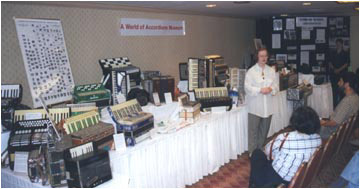 The
history of accordions is a history of the creative spirits of peoples of
many cultures. It involves awareness of the values and aesthetics of cultures
as represented in the music, song-texts, and artistic life of real people.
On all continents of the earth, creative artistry is represented and delivered
by accordion-family instruments. This music cannot be understood without
knowledge of the instruments themselves, what they were created to accomplish,
and the means given to the tasks. Preserving accordions, then, can be seen
as a study of humanity. This is the goal and task of A World of Accordions
Museum and Harrington ARTS Center. The
history of accordions is a history of the creative spirits of peoples of
many cultures. It involves awareness of the values and aesthetics of cultures
as represented in the music, song-texts, and artistic life of real people.
On all continents of the earth, creative artistry is represented and delivered
by accordion-family instruments. This music cannot be understood without
knowledge of the instruments themselves, what they were created to accomplish,
and the means given to the tasks. Preserving accordions, then, can be seen
as a study of humanity. This is the goal and task of A World of Accordions
Museum and Harrington ARTS Center.
Beginning
with early accordions and concertinas (1829) and progressing chronologically
to modern state-of-the-art examples, this session will sound, identify and
explain the complex family known as bellowed free-reed aerophones through
their major representatives: piano, button chromatic, button diatonic accordions,
English, Anglo, Chemnitz concertinas, and Bandonions. Beautifully artistic
historic examples as well as hybrids and rarities will be part of the display
and demos. Audiences are usually astounded by the varieties and tunings,
and the acquired knowledge base enhances appreciation.

When a great actor defines his role, he succeeds through rationalized features of delivery - more than just reciting the words written in his script. Underlying his art is intelligent understanding of flow and development, called interpretation. Although delivered as if through spontaneous inspiration, its elements have been studied, practiced, varied, evaluated, and controlled, just the same as your music when well prepared.
Music’s adage as “the universal language” belies the fact that its content - notes, melody, harmony, construction - can be understood in various ways by different interpreters. Notation provides only the necessary tone sequences, but when you play, you determine the composition’s evolving flow and emotional substance. Your understanding of the content, your technical control of the instrument, your intrinsic musicality, and your creative intelligence determine the persuasiveness of your performance. Attention to details during preparation contributes to your perceived status as a note-player or as an artist.
The goal of this workshop is to provide guidelines that will aid in learning to play artistically, from early practice sessions through polished public performance. Demonstrated pieces at intermediate level, and a little beyond, illustrate suggestions for rapid learning and progressive security through effective practice. Hand-out materials for “Preparation,” “Performance Moments,” and “Objective Evaluation” incorporate suggestions for layering concentration, practicing sound effects, and learning impartial assessment. They include details related to technical skills, understanding balance between sections of the instrument (as in “partial depression”), aspects of style, “singing” phrases, shaping the whole composition, and more!
|
 |
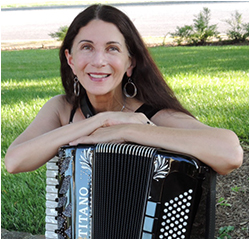 This workshop is designed for accordionists who enjoy the unusual rhythms and beautiful melodies of the Balkan region, but need a little “push” to try to tackle this music on their own. Joan will introduce accordionists to the “mathematical system” of Balkan rhythms. Within minutes, what seemed difficult and confusing will become exciting and fun. She will give out music for three lovely Macedonian songs, so bring your accordions and music stands! The art of the hauntingly beautiful Balkan harmonies will also be introduced and dances demonstrated. This workshop is designed for accordionists who enjoy the unusual rhythms and beautiful melodies of the Balkan region, but need a little “push” to try to tackle this music on their own. Joan will introduce accordionists to the “mathematical system” of Balkan rhythms. Within minutes, what seemed difficult and confusing will become exciting and fun. She will give out music for three lovely Macedonian songs, so bring your accordions and music stands! The art of the hauntingly beautiful Balkan harmonies will also be introduced and dances demonstrated.
Joan Grauman, a piano performance major, international folk dancer and choreographer, switched to the piano accordion in her early 20s to play the beautiful music of the Balkan countries. She loved the exciting melodies and the intricacies of the region’s rhythms and dances. Joan was the accordionist in the popular Balkan dance band, BAMCO from 1983 to 2001. Today, Joan is the music director of the Potomac Accordion Ensemble (Washington, DC) and the archivist for the American Accordionists’ Association.
|
 |
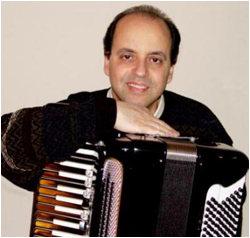 This workshop will show you some of the inexpensive and even free recording tools you can use at home in today's world to get top quality recordings in your own home music studio, office, or living room! With accordion being one of the more difficult instruments to record effectively, you will be very interested to see some of the tips and tricks to record not only accordion, but other instruments as well. This will be a hands on demo so that we can show recording results during the workshop, including final CD production and labeling. This workshop will show you some of the inexpensive and even free recording tools you can use at home in today's world to get top quality recordings in your own home music studio, office, or living room! With accordion being one of the more difficult instruments to record effectively, you will be very interested to see some of the tips and tricks to record not only accordion, but other instruments as well. This will be a hands on demo so that we can show recording results during the workshop, including final CD production and labeling.
Joseph has been a performer and advocate of the accordion since the age of 7. Joe started his studies with prominent Ohio accordion teacher, the late Mickey Bisilia of Youngstown, Ohio. Like many other accordionists of his time, Joe developed his classical performance skills in state and national competitions hosted by the American Accordionists' Association (AAA), eventually winning its national title at the age of 18 in Washington, D.C..Later that year (1972), Joe became the AAA United States representative in the Coupe Mondiale world accordion competition held in Caracas, Venezuela, where he was chosen first runner up.
Joe later furthered his music education, receiving his Bachelor and Master of Music degrees (1976 and 1977 respectively) in composition and electronic music at the University of Toronto, where his principal composition teachers were John Weinzweig, Edward Laufer, and Gustav Ciamaga.
|
 |
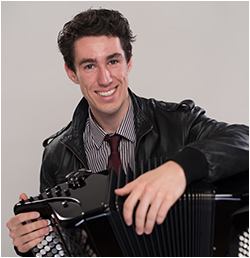 World V-Accordion silver medalist and two-time Canadian V-Accordion champion Michael Bridge shares what he has learned in years of V-Accordion programming. For any level of Roland user, this workshop will offer some shortcuts and new ideas on how to get the most from your accordion. World V-Accordion silver medalist and two-time Canadian V-Accordion champion Michael Bridge shares what he has learned in years of V-Accordion programming. For any level of Roland user, this workshop will offer some shortcuts and new ideas on how to get the most from your accordion.
If you are considering purchasing a V-Accordion but are unsure of what it can do, this is also the workshop for you! Please feel free to bring lots of questions.
Canadian accordion champion and winner of the University of Toronto Concerto Competition,
Michael Bridge uniquely fuses classical, pop-rock, jazz and world music.
Michael made his solo
orchestral debut with the Boston Pops at age 16, and has performed in Asia, Europe, and North
America, now giving over 100 concerts per year. In 2013, he placed 2nd at the world digital
accordion championships.

Five types of bellows shakes, how to bend a note, vibrato, and other physiological techniques will be demonstrated and explained in this workshop. We will also discuss what special bellows techniques can really help your instrument sound at its best, motivated by what Michael has learned during his degree at the University of Toronto. All levels of players are welcome; please feel free to bring lots of questions!
|
 |
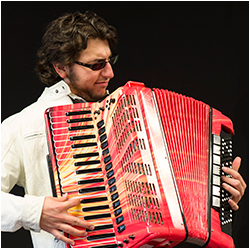 Cory will take simple tunes known by all, and work them through the machines of various genres to show the intricacies of each, and how the same song can sound completely different in a large amount of aspects, using Ornamentation, Feel, Tempo, Groove, Type of Improvisation, Scales, Chord Changes and Substitutions, and more. Cory will take simple tunes known by all, and work them through the machines of various genres to show the intricacies of each, and how the same song can sound completely different in a large amount of aspects, using Ornamentation, Feel, Tempo, Groove, Type of Improvisation, Scales, Chord Changes and Substitutions, and more.
See what it means to Truly play Klezmer to Jazz to Irish and many more versus just playing a written arrangement in a certain genre.
Cory Pesaturo (“C Pez”) is a graduate of the prestigious New England Conservatory of Music in Boston, MA, where he was the first musician ever to major and graduate in the accordion. Pesaturo is one of only four accordionists to win a World Championships competition on both the Acoustic and Digital Accordion, and is the only person to ever to also win a World Championship in Jazz.
|
 |
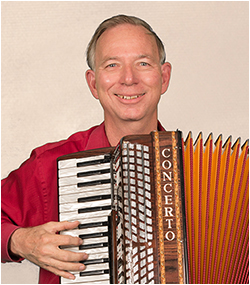 This workshop will emphasize looking at a student music arrangement and choosing places in the melody
to add an ornament, harmony, fill-in pattern, bass substitution, rhythm style, bellow shake, trill and
more. We will look at a student teaching arrangement and build a more enjoyable and playable This workshop will emphasize looking at a student music arrangement and choosing places in the melody
to add an ornament, harmony, fill-in pattern, bass substitution, rhythm style, bellow shake, trill and
more. We will look at a student teaching arrangement and build a more enjoyable and playable
song version for student skill development, play-outs, and on a gig. The elevated skill of improvising
music for yourself and other accordionists can be fun, motivating and heighten the desire to play
the accordion for public venues.
A set of useful easier improvising ornaments, fill pattern types for both treble and bass clef play and a practical set of chords for the intermediate accordionist will be given to class participants. My goal is to structure this class for the teacher, student and musician. We will look at a contemporary song, Latin, Italian, French and jazzy Swing tunes for using improvising tools. Please consider bringing color pencils to the workshop. Thank you in advance for your participation.
|
 |
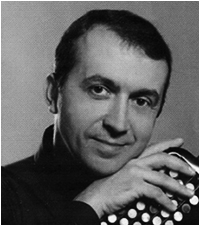 In his presentation, our International guest artist Yuri Shishkin (Russia) will share his insight and thoughts on what a modem accordionist can do. Himself, a master transcriber, he will discuss how orchestral and piano transcriptions sound on the accordion and why? Furthermore, Yuri will show a few bellows approaches and how he learned them. In his presentation, our International guest artist Yuri Shishkin (Russia) will share his insight and thoughts on what a modem accordionist can do. Himself, a master transcriber, he will discuss how orchestral and piano transcriptions sound on the accordion and why? Furthermore, Yuri will show a few bellows approaches and how he learned them.
His discussion will also include his thoughts about the differences of how to become a musician, versus just an accordionist. To him, it's extremely important to differentiate the difference between striving to become an outstanding 'musician' as opposed to just an outstanding 'accordionist'.
The workshop will conclude with a question and answer session.
|
More workshops to be announced soon! Please check back. |
|
Lisle, (Chicago) Illinois
July 17-21, 2013
|
|

